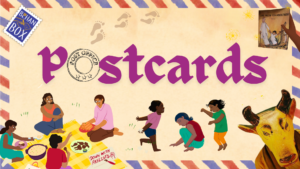Postcards: From An Ambedkarite Jalsa To James Baldwin’s First Lines
This month in Postcards: notes about Catan, scribbled-out games of FLAMES, crime and companionship in Sarah Paretsky’s world, and more
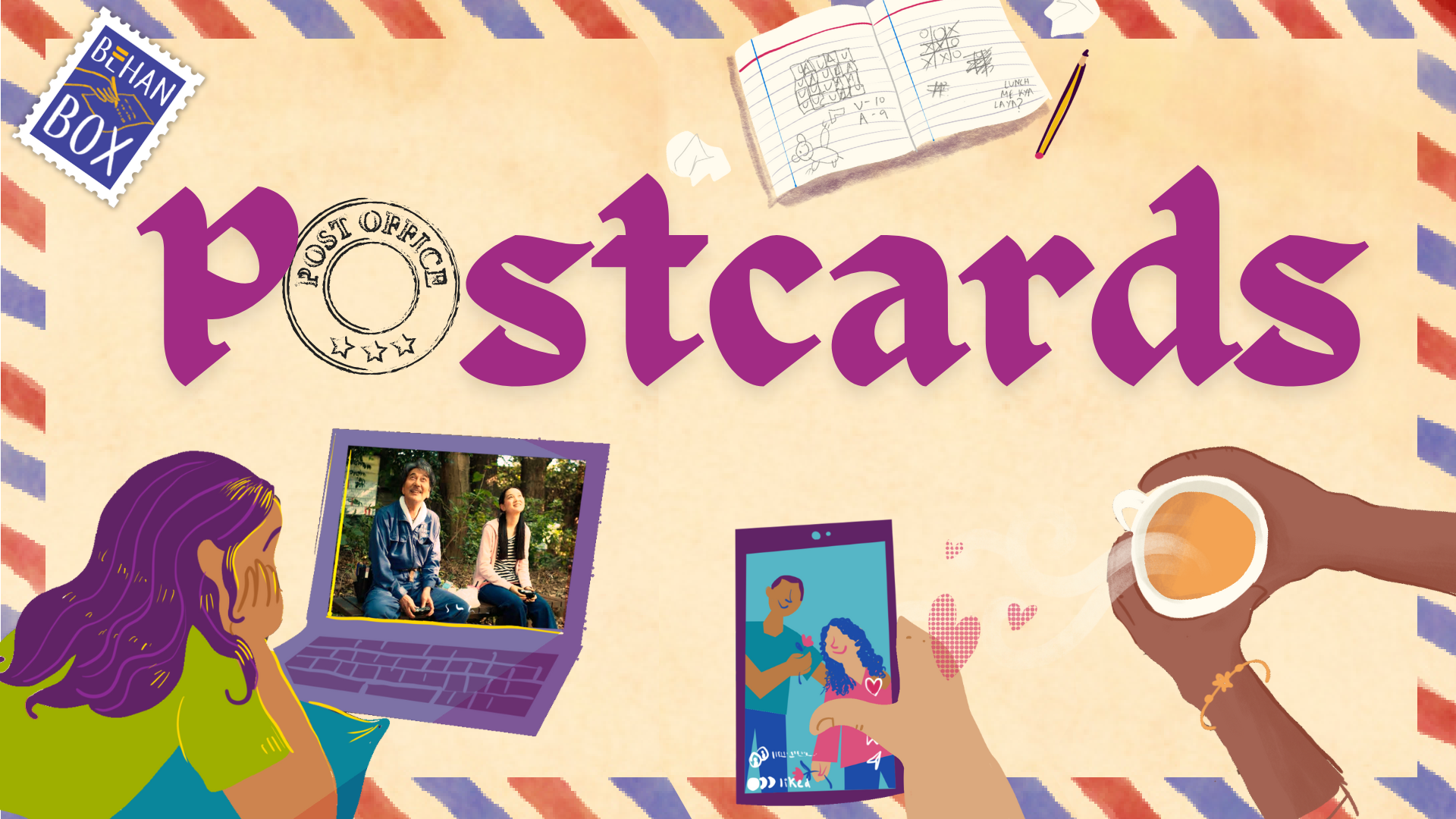
Dear reader, we write to you about the people, places, and ideas that brought team BehanBox joy this month. One postcard, every month.
Temporary Suspension of Doom
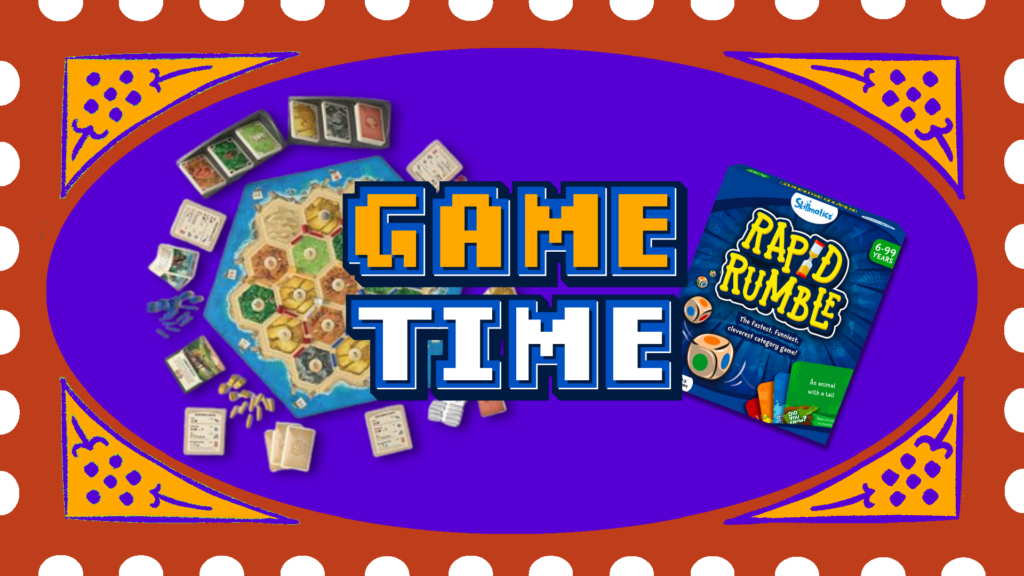
It starts with someone declaring: “I have the longest road!” or “Avi, stop using the robber on my hex!” Or my dad grumbling good-naturedly while I sneakily stock up on sheep. In my home, Catan is slowly but surely becoming a serious affair. We play as if global diplomacy hangs in the balance. But somewhere between under-the-table negotiations and robber placements, we laugh so hard our stomachs hurt. Everyone gets a turn. Everyone has a say. No one checks their phone. It’s pure, collective absorption.
With my husband, it’s Othello. He’s always convinced he’s lost, until, magically, he wins. Or vice versa. We end up bickering over who goes first and then dissolving into giggles.
Rapid Rumble comes out when we have guests, and the living room becomes a chaos zone. Words shouted across the room, food left half-eaten, people flinging category cards and yelling “Fish that starts with M!” like it’s the key to world peace.
In these moments, something opens up. Not just time, but a pocket of reprieve. People forget they’re job hunting, or tired of their bodies, or nursing heartbreak. They forget what is wrong. What remains is only the joy of play, the kind that’s equalising, belly-shaking, and oddly healing.
As a child, I thought play was for children and stress was for adults. But if there’s one thing adulthood has shown me, it is that joy has to be made. Stolen, even. Found in tiny rituals—cutting fruit and shuffling cards, someone opening the box and saying, “Just one round,” knowing we’ll be here all night. These games don’t fix anything. But they soften the edges. The world, so often absurd, unjust, and exhausting, can still be kind enough to let a Sunday evening unfold with laughter and joy.
Anannya Parekh
Baldwin, Velvet Ideas and Joy
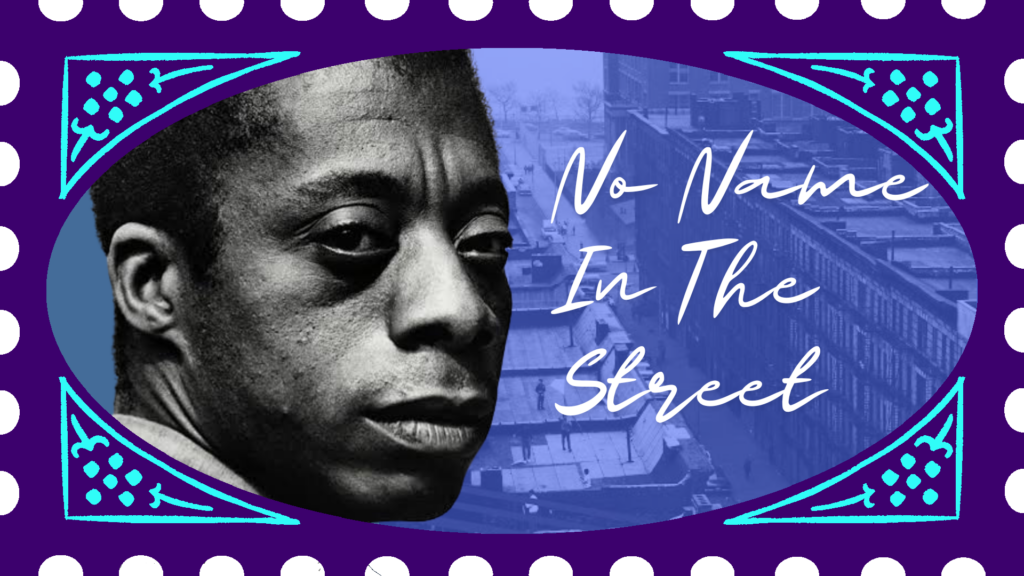
Over the past few months, to shock myself out of a slow-reading phase, I kept returning to James Baldwin, whether in paperbacks gifted by gracious friends, or bookmarked online links. The last time I read was during the pandemic, where words were company, survival and conversation. Now, in a post-reading haze, as a friend and I read Giovanni’s Room, we traded the same barrage of messages. How can this man write like this? Cannot able to, yappa, ushoo, ufff, and so on.
I’m a sucker for first lines of books or poetry – the words swirl around in my mind and leave only when they are savoured and scrawled on scraps of paper. In June, I had to sit down and take a deep breath after reading the first paragraph of Baldwin’s No Name In The Street. The first line in this non-fiction work, one I chose not to paraphrase goes like this: “That is a good idea,” I heard my mother say. She was staring at a wad of black velvet she held in her hand before carefully placing it in a closet. We can guess how old I must have been from the fact that and for years I thought that an ‘idea’ was a piece of black velvet.”
An idea as black velvet. I can never shake this metaphor, never un-feel its “velvet weight”. An idea woven from strands of thought, softly brushed up inside a mind, a certain warmth that emanates from creative output. In college, a professor once told us about how reading was a source of jouissance, a French term for joy or rapture. This word floated back from the depths of my memory. Then, I noted it down now, as I return to reading, there’s jouissance in first lines and Baldwin. All I’ve been thinking is black velvet, how can this man write like this? Cannot able to, yappa, ushoo, ufff, and so on.
Archita Raghu
A Jalsa of Resistance

“Mmmmm..yeh Hitler ke saathi, janaazon ke baraati,” he began on a very high note. The tabla and parai drum followed. “Poochte nahin insaan ko, kaun hai tu. Poonchte hain dharm aur jaati (these friends of Hitler, these peddlers of corpses/They don’t ask if you are human, they ask your religion and caste).”
The crowd was in raptures. Sambhaji Bhagat, the popular Lok Shahir from Maharashtra, does not need a stage. He makes his own. That evening, in the auditorium of the School of Oriental and African Studies (SOAS) in London, he served unvarnished truths and provoked thought with his pithy prose and poetry, to an audience of students, academics, journalists, activists, in a three-hour-long Ambedkari Jalsa – a form of social and cultural expression of Ambedkarite thought that originated in Maharashtra. The air was thick with resistance with Sambhaji’s vocals, and the beats of the leather drum parai, a symbol of Dalit resistance, played by Manimaran from Tamil Nadu.
And I had the front row seat to it.
“I am not here to entertain you. I’m here to disturb you. I’m here to sing a thought,” Sambhaji told us.
His songs connect the global with the local. ‘Soorat ko pehchano’ lays bare the transnational political economy of hate. Sample this:
“Silicon ki valley mein, Siyaram ka market hai bhai
Wall Street pe baithe hain, vanar sena ban gaye hai bhai
America se dete hai jhatka, Ayodhya mein khaya hai phatka”
[Silicon Valley is the marketplace of the politics of Ram and those on Wall Street are its foot soldiers/One push from America and the ground shifts in Ayodhya.]
In his Marathi song ‘Palakicha Bhoi’ (palanquin bearers), he critiques the intellectuals who uphold the Brahminical elites and casteist structures, calling them the state’s ‘palanquin bearers’. His songs offer Marx’s class analysis with Ambedkar’s emancipatory thought – ideas that many in the audience spend a lifetime developing, problematising and complicating while poring over fat texts.
His performance is powerful, humour sharp, and intellect sound. He uses Dharavi slang and asks the London audience, “You understand?”
One moment, he launches his satire on the charlatan babas that have quite literally held the nation’s breath and in the next, tells us that the crisis we are in is not social, political or economical but philosophical. And that we need a new form of radical emancipatory cultural politics from below. Such music can do what speeches, podcasts and texts do not – inspire people to thought and action.
A contingent of Pakistanis in the audience is moved. “Aap Pakistan ayein,” they say.
“Haan ayega na mai. India mein humko bolta hai ‘Go to Pakistan,’” he replies.
Bhanupriya Rao
Meet VI, My Literary Companion
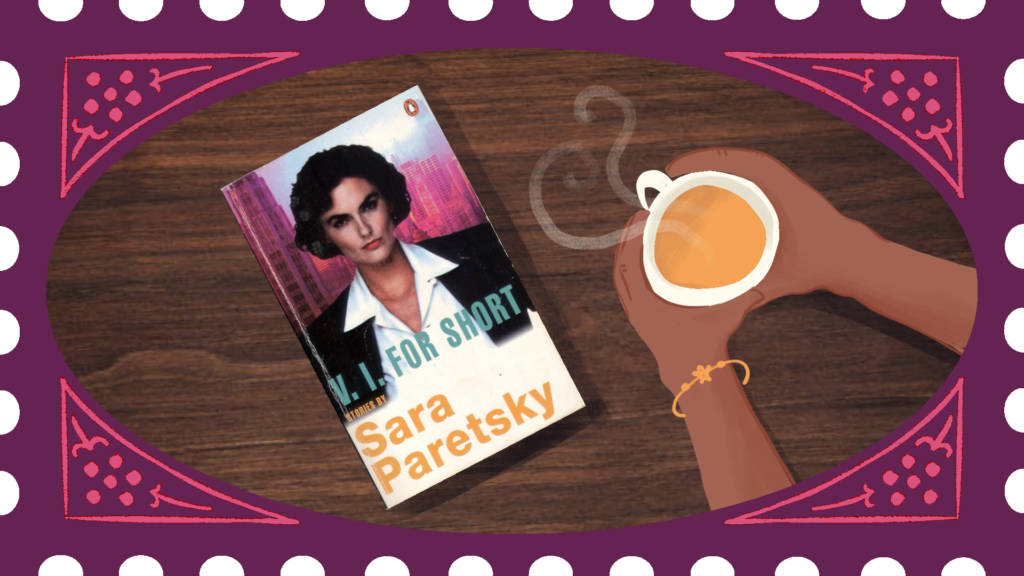
I could not have found a better alter ego than private investigator Victoria Iphegenia Warshawski when I ran into her in the pages of a book 30 years ago. I was pregnant, nauseous, could only eat jam and toast down and felt sick at the smell of detergent powder. She was athletic, fearless, fierce, reckless and stubborn. She leapt from page to page of Sara Paretksy’s brilliant books, breaking down every door in Chicago to get to the truth of terrible crimes, beating up villains, taking on the mob, police, politicians, property sharks, and business bullies. Every few pages, she would be battered and bruised but up before the wounds healed to return to where she got the beating.
VI, as we fans call her, could not be bothered with being feminine — with her hair or clothes or cooking or housekeeping — had two lovely golden retrievers and one very indulgent landlord. As for love, she is, according to Paretsky, a serial monogamist. It is not that there were no women sleuths before her — Miss Marple came decades before and VI had many contemporaries — but none had her grit or smarts.
“Pretend I’m a dog,” VI says once to a character. ‘Half Rottweiler, half pit dog. I’m loyal but fierce. And valiant. Don’t forget valiant.”
It is now nearly 30 years since VI and I entered into literary companionship. Starting with Indemnity Only, she has gone on to star in 22 of Paretsky’s books, the last one Pay Dirt, arrived last year and the next, Bad Company, is lined up for 2026. In the meanwhile, as she bashed up baddies, she has been in a couple of relationships, gone from rooting through secret documents in the still of night to using the internet and dealing with the pandemic. But Paretsky has not aged her. There is after all enough grief in the world without VI getting arthritis.
Malini Nair
Lost And Found In Translation
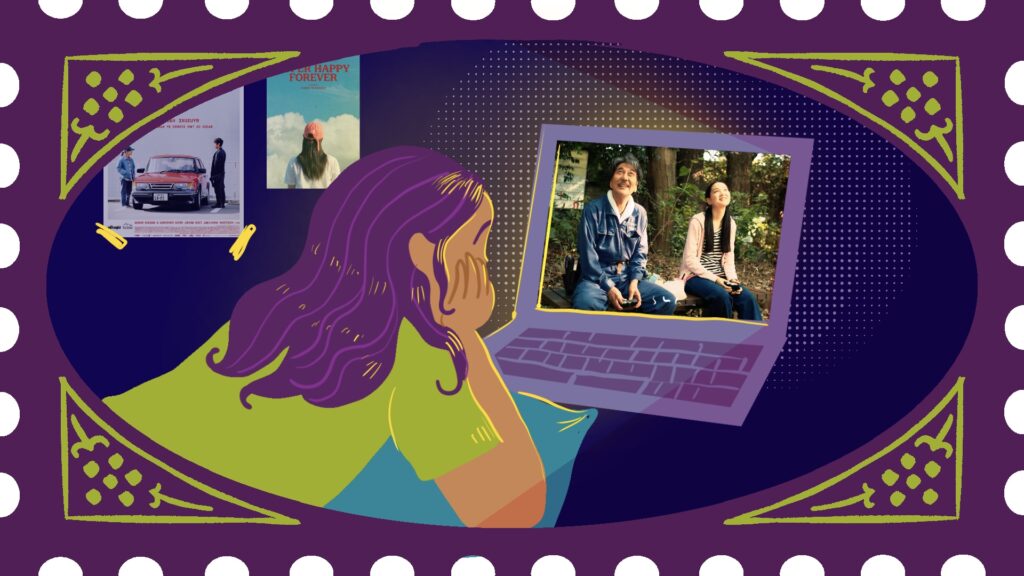
“I’m getting some bits of what they’re saying!!” I scrawled across my journal while watching Kohei Igarashi’s Super Happy Forever. Excited sentences follow, in English and Japanese, of unexciting sentences the pair exchange. Ima nanji desuka (what time is it now)? Ganbatte (good luck). Then notes about how the movie resists the women in refrigerators trope (when women’s death is used as a plot device to advance the narrative, think Deadpool or basically most comic books written by men); or using the location to hold two distinct memories separated by time. Igarashi used – in Richard Linklater style – silences, conversations, walking, stillness to let a love story unfold in reverse.
We are told at the start their marriage won’t be a happy one, but l play detective: hanging on to each word exchanged between lovers or any shot with a legible script in the backdrop to look for signs; I’m hoping that their intonation or choice of adjectives will explain their connection, or layer the context that makes their memories. I was beguiled, a fate I happily accepted.
This exercise was done first with Drive My Car, then Perfect Days. My ears were tuned for familiar phrases, eyes prime to spot the local konbinis (convenience stores) and sentos (public bathhouses). I paused and rewinded to recollect the vocabulary, to enunciate the words clumsily but with growing confidence. Something about the familiarity with language helped me enter and be at ease with these worlds, to let its towns seep into my imagination, to feel the grief and loneliness. My heart skittered when Hirayama said Kondo wa kondo, ima wa ima (next time is next time, now is now) in Perfect Days, mostly because I had only recently learned the translation for ‘now’ and ‘next time’.
I learned Japanese in school, five years of tests and exams and cultural trips, remnants have since curdled up in memory. We watched Grave Of the Fireflies and Spirited Away back then, but there was so much I didn’t understand. I went back to the language some 363 days ago – Duolingo logs my daily ritual – and it’s more playful now, even if irregular, this learning. I make my own modules: some Duolingo quests, YouTube videos, a handy dictionary. No tests, no measure of progress, but I don’t mind. Every now and then I notice something I wouldn’t have a decade ago. Did you know the Kanji script for rain literally looks like rain drops falling against a window? See: 雨.
Saumya Kalia
On Public Displays Of Affection (and Being Seen In Love)

A friend recently stayed with us for a few weeks. During that time, she captured small moments between my partner and me – quiet glances, shared laughter, routine gestures that usually pass without much thought. She documented and stitched these moments into a short reel later and posted it.
Watching it filled me with warmth. And I watched it at least 15,432 times and each time, I smiled. My partner and I often spend weeks apart because of my travel, and while we stay close through texts and calls, nothing compares to the small dailyness of being around each other. That reel held the essence of what we miss during those stretches: the soft, wordless ways we remain tethered.
In a world where loneliness gnaws at us, where so many of us live far from our loved ones, physically or emotionally, it felt meaningful to be reminded of closeness. To witness tenderness. To be seen in the act of loving and being loved.
The reel wasn’t dramatic or performative. It was ordinary, and perhaps that is why it was so moving. It was a small archive of our shared life, the kind of affection that survives distance, disruption, and the pace of everyday living. It made me feel grateful for partnership, for friendship, and for the reminder that even in the scattered rhythm of our lives, love leaves traces. Sometimes in memories, sometimes in gestures, and sometimes, if we’re lucky, in a reel that holds it all together.
Shreya Raman
Last Page Of the Notebook
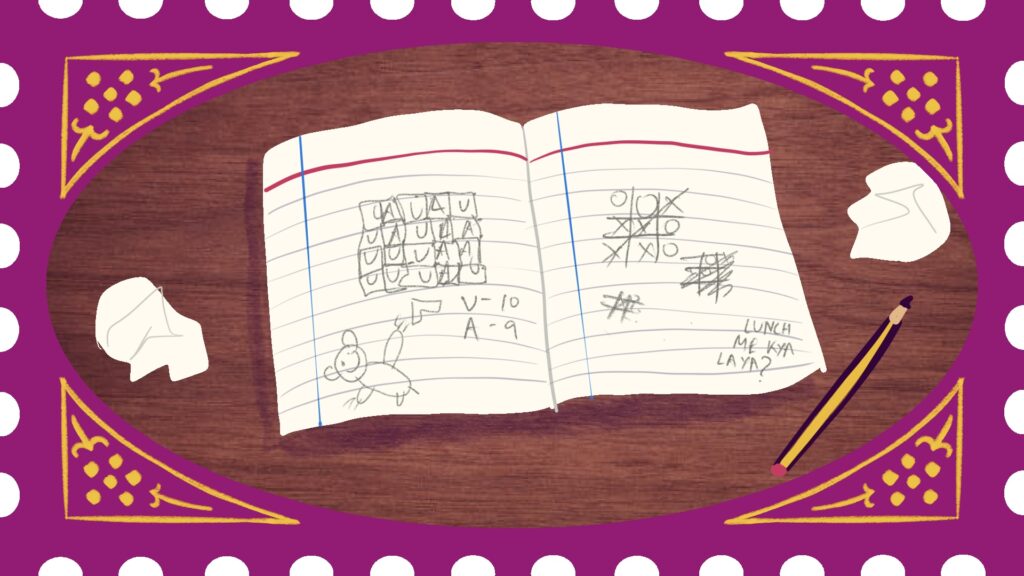
You’re in the back row of a snoozefest of a class, trying to keep your eyes open as the teacher rambles on, and the only thing that saves you, as you pretend to take notes, is the last page of your notebook. The “game page”. Covered in tic-tac-toe grids, endless rounds of Dots and Boxes, cartoon doodles, and scribbled-out games of FLAMES. The last page was where boredom went to die. I stumbled into this graveyard while trying to find ways to keep my nieces entertained, to keep them off their screens, and the game page was an exciting proposition. I was surprised to find they didn’t know Dots and Boxes.
It’s one of those simple, pencil-and-paper games that almost anyone can pick up. Two players take turns drawing lines between dots on a grid. The goal is to complete a box, if you draw the fourth side, you claim it with your initial and are rewarded with another turn. Whoever with the most boxes in the end wins.
These games aren’t just mindless time-passers, there’s actually a lot of strategy hidden in those little lines and dots. I came across Elwyn Berlekamp’s book The Dots and Boxes Game: Sophisticated Child’s Play, which dives into the game through a lens of combinatorial game theory. There’s a whole world of math and tactics behind something that looks so simple. The game itself has been around for quite a while, published first in the 19th century by a French mathematician named Édouard Lucas, who is better known for his work with number sequences like the Lucas numbers (related to Fibonacci). Turns out, Lucas also had a knack for creating clever games like this one.
Back before the internet took over, most of my school days were filled with little paper games like this. We’d rip out the last page of our notebooks to make origami fortune tellers, draw elaborate role-playing maps, or play endless rounds of tic-tac-toe and Dots and Boxes. We didn’t call it analog gaming back then, it was simple play, not an escape or alternative in a world overloaded with screen fatigue, apps, and endless notifications. I watched my nieces draw lines and close in boxes, laughing, plotting, trying to outsmart each other. I look back now and think how amazing it is, what a simple pencil and piece of paper could do.
Urvi Sawant
What movie, book, art, sight or sound inspired you this month? Mail us your postcards at contact@behanbox.com using the template below (or simply write to us). We’ll share your missives with our readers on social media.

Your monthly brain teaser about gender, care, and politics with no perfect answers.
IIT Kharagpur is piloting a ‘Campus Mothers’ initiative where only women residing on campus will be trained to provide informal support to students. But while the well-intentioned pilot creates room for emotions in a hyper-competitive system, the stereotypes are evident: only women are capable of empathy, and said emotional care should be administered free of cost. And does it do anything at all for students’ well being, whose access to mental health aid is shaped by complex realities of caste, class, language, and access? For now, help us think through this:
What does a distressed student need: a ‘campus mother’, a ‘campus mentor’, or a higher volume of trauma-trained mental health practitioners?
Write to us with your thoughts.
Behan’s Responses
The sweltering heatwaves had led us to a mathematical question about gender and income. If women spend more time doing the same work due to heat fatigue, and overall get paid less for the day, are they suffering a financial loss, or earning the same as before?
“If you are working four extra hours for the same amount of work, then you are experiencing an economic loss; however, that is not how economics works,” Vidhya Venugopal, a scholar at Sri Ramachandra Institute of Higher Education and Research (SRIHER), told our reporter Shreya Raman. The logic might seem straightforward but economists require cold, quantitative evidence which is hard to gather in the vastly dispersed informal sector. Women in their lives are suffering a financial loss, but it remains unaccounted for because economic instruments are not designed to measure the complex impact of heat on women and other workers.
Want to explore more newsletters? Our weekly digest Behanvox and monthly Postscript invite you, the reader, into our newsroom to understand how the stories you read came to be – from ideation to execution. Subscribe here or visit our Substack channel for more.

We believe everyone deserves equal access to accurate news. Support from our readers enables us to keep our journalism open and free for everyone, all over the world.

